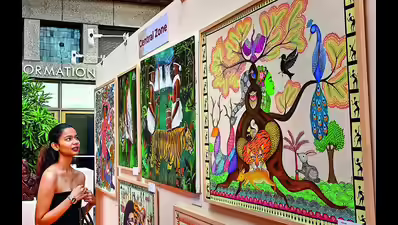Tribal Art Exhibition 2025 titled “Silent Conversations: From Margins to the Centre” brings alive the deep emotional and cultural bonds between tribal communities and tigers. The exhibition, held at New Delhi’s India Habitat Centre, features around 250 paintings and crafts by more than 50 tribal artists from over 30 tiger reserves across India.
Organised by the Sankala Foundation with support from the National Tiger Conservation Authority (NTCA) and the International Big Cat Alliance (IBCA), this fourth edition aims to spotlight conservation, traditional wisdom, and the lived experiences of forest communities. The exhibition runs for four days (October 9–12) and also features a national conference on Tribal Arts and India’s Conservation Ethos: Living Wisdom.
The artworks on display draw from the folklore, daily life, struggles, and ecological perspectives of tribes living in buffer zones of tiger habitats. Forms such as Gond, Warli, Saura, and Pithora are woven into visual narratives that depict how these communities coexist with big cats, forest ecosystems, and nature itself.
One striking piece tells the story of Maya, a famous tigress from Tadoba-Andhari, capturing how local inhabitants see the tiger as more than wildlife — as a guardian, mother figure, or even kin. Other works show how tribal life, forest cycles, rivers, and human-animal boundaries overlap and converge.
This exhibition is not merely artistic — it bears deep environmental significance. By offering a platform to tribal voices, it challenges urban audiences to reconsider conservation beyond scientific discourses. It underscores that tribal communities are custodians of ecological wisdom, resisting exploitative practices, and maintaining delicate balances between livelihood and nature.
Proceeds from artwork sales are credited directly to the artists, ensuring economic benefit reaches grassroots creators. The accompanying conference brings together conservationists, policymakers, scholars, and artists, focusing on how traditional knowledge systems can inform modern conservation strategies.
This Tribal Art Exhibition 2025 demonstrates how exhibitions can serve as bridges — between urban and forest, art and activism, conservation policy and community stories. It affirms that environmental protection is inseparable from cultural identity and human rights.







